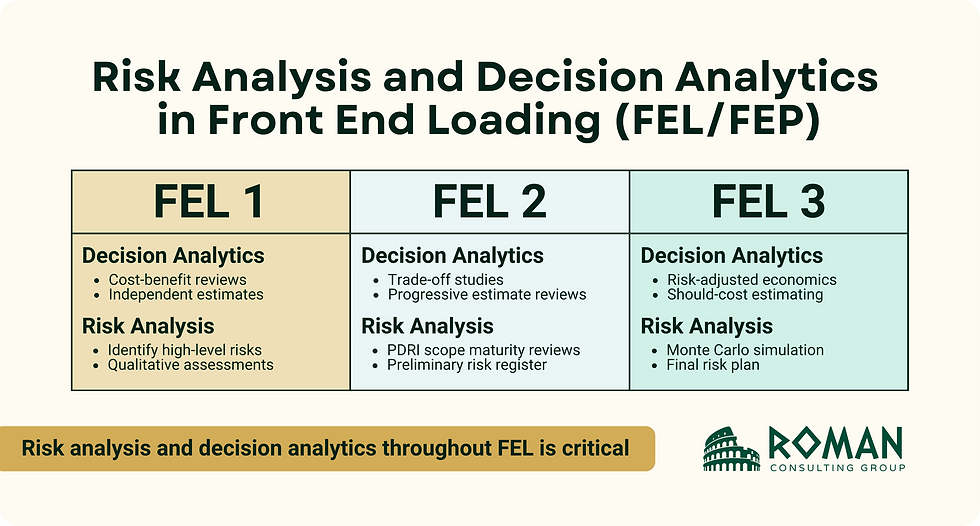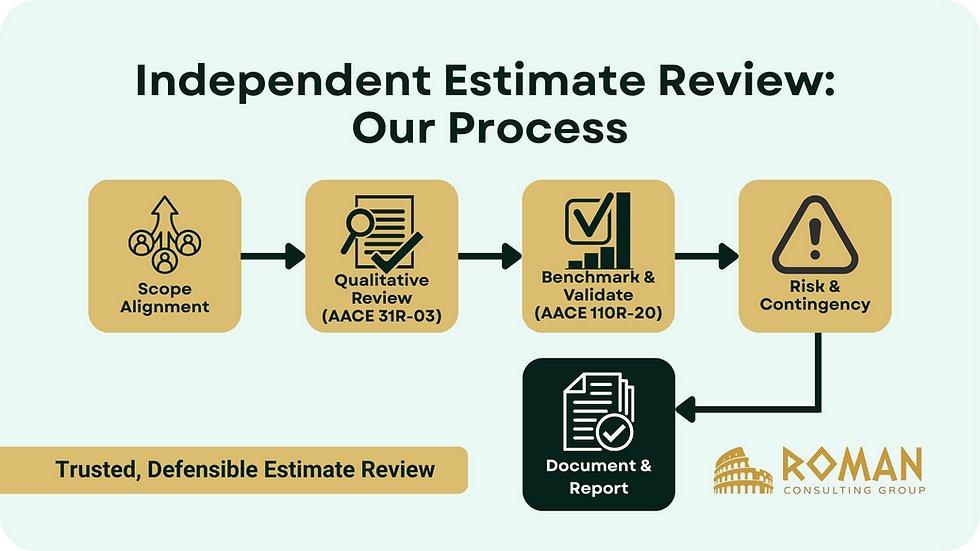Project Definition Rating Index (PDRI) in Capital Projects
- Roger Farish

- Aug 25
- 3 min read

What Is the Project Definition Rating Index (PDRI)?
The Project Definition Rating Index (PDRI) is a structured methodology developed by the Construction Industry Institute (CII) to measure how well a project’s scope has been defined during front-end planning.
It provides a 1,000-point scoring framework where a lower score = better scope definition (like golf).
Each project is assessed against a set of standardized elements, grouped into three sections:
Basis of Project Decision (business objectives, strategies, feasibility)
Basis of Design (processes, site data, technology, equipment scope)
Execution Approach (plans for procurement, controls, execution, and startup).
Each element is rated on a scale from 1 (complete definition) to 5 (poorly defined), with non-applicable elements scored as 0.
By converting subjective scope discussions into quantifiable scores, PDRI helps teams identify gaps, reduce risk, and align stakeholders.
Benefits of PDRI in Capital Projects
Capital projects benchmarked using PDRI show significant performance improvements:
Up to 25% cost savings
Up to 17% schedule reduction
Lower incidence of change orders and disputes.
CII’s research has shown that projects entering execution with a PDRI score below 200 perform markedly better than those above 200. In fact, industrial projects with high maturity (>80 percent) and high accuracy (>76 percent) at the end of FEED significantly outperformed their peers in both cost and change order performance.
How a PDRI Session Works in Practice
A PDRI session is a structured, facilitator-led workshop that brings together all key stakeholders including the owner, EPC, licensors, contractors, and operators.
The facilitator walks the team through each element, asking:
How well is this defined?
Where are the gaps?
What action items are needed?
The result is:
A PDRI score that reflects the overall scope definition level.
A list of gaps and actions that need to be closed before proceeding to the next stage gate.
Documentation that directly supports a project’s Basis of Estimate (BoE), strengthening the quality of cost and schedule baselines.
PDRI Templates for Different Project Types
PDRI is not one-size-fits-all. CII has developed multiple templates tailored for different project types:
Industrial Projects (refineries, LNG, chemical plants, power, manufacturing)
Building Projects (offices, schools, hospitals)
Infrastructure Projects (pipelines, railways, highways)
Manufacturing and Life Sciences (MLS)
Mining Projects
Small Project Variants for industrial and infrastructure projects under specific cost thresholds.
For industrial projects, strong scope definition becomes a direct input to should-cost estimating, improving negotiations with vendors and contractors.
PDRI MATRS and the Role of Maturity and Accuracy
In 2019, CII enhanced PDRI with the Maturity and Accuracy Total Rating System (MATRS).
Maturity measures the completeness of FEED deliverables.
Accuracy evaluates the environment in which planning occurs such as leadership, team, resources, and processes.
Together, these provide a richer view: not just how well the deliverables are defined, but whether the planning context gives confidence that those deliverables are reliable.
Why Organizations Adopt PDRI in Their Governance
When embedded into governance, PDRI becomes more than a checklist. It is a discipline for reducing bias and improving decision quality. Organizations that adopt PDRI consistently report:
Predictable outcomes at sanctioning and execution.
Improved alignment between owners, EPCs, and licensors.
Transparency on scope risks.
Benchmarking capability across portfolios for continuous improvement.
Final Thoughts on PDRI and Cost Certainty
Front-end planning determines whether projects succeed or fail long before construction begins. The Project Definition Rating Index provides a structured, proven, and widely adopted framework to bring objectivity, alignment, and risk visibility into this critical stage.
At ROMAN Consulting Group, we help clients facilitate PDRI sessions and independent estimate reviews, ensuring scope clarity, stronger investment decisions, and greater cost certainty. These reviews often extend into independent estimating support, giving owners and EPCs confidence that cost baselines reflect both scope maturity and market realities.
FAQ: Project Definition Rating Index (PDRI)
'What is a PDRI score range?
PDRI uses a 1,000-point scoring system where lower is better. A score under 200 is considered well defined and indicates lower project risk.
When should PDRI be used in a project?
PDRI is applied during front end planning. It is typically used at least twice: once early to identify gaps and again before authorization to validate scope completeness.
What is the difference between PDRI and PDRI MATRS?
PDRI MATRS enhances the original PDRI by adding accuracy factors. It not only measures maturity of scope deliverables but also assesses the environment in which planning occurs.





Comments